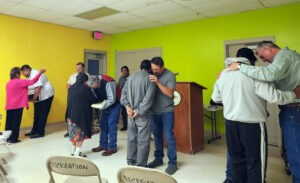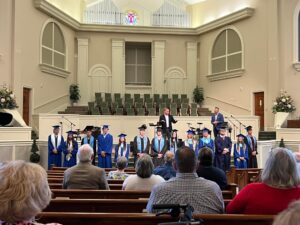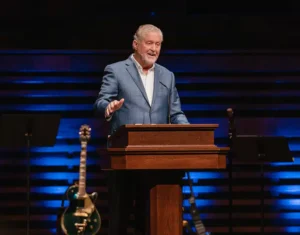
RIDGECREST, N.C. (BP)–For many people, the image of a chaplain is Father Francis Mulcahy from the long-running television series “M*A*S*H” who gently ministered to military personnel of all religious denominations -– and some who never attended church.
While chaplains do provide much-needed comfort to military personnel, they are dispersed in all walks of life -– at the workplace, on disaster relief sites, among police and firefighters and in places like athletic venues and horse barns.
That’s why LifeWay Christian Resources in conjunction with the North American Mission Board added a chaplaincy track to the annual National Evangelism and Discipleship Conference at the LifeWay Ridgecrest Conference Center in July.
During several of the conference’s main sessions, chaplains were recognized, and some told of their various ministries. Conference organizers were hoping for about 50 people in the track — but the number was closer to 80.
“Why [did we emphasize] chaplains this week? That is the church at large,” said Jay Johnston, LifeWay’s director of evangelism and discipleship. “They are wherever the mission field may be. They are men and women from local churches who go out and minister to the public.”
Steve Dyess, chaplaincy evangelism associate for the North American Mission Board, said it’s important for people to develop a new mindset regarding chaplains.
“We try to tie everything in to the local church,” Dyess said. “Chaplains are an outreach of the church. It’s not something churches have to be threatened by. Chaplains are similar to missionaries and sometimes people don’t realize that. Chaplains go outside the walls of the church and minister to the community.”
Sessions in the track included biblical foundations for chaplaincy, ministry to Muslims, volunteer community chaplaincy and individual crisis intervention and peer support. Disaster relief chaplains, meanwhile, could attend crisis intervention seminars in order to receive 13 credit hours toward CISM certification (Critical Incident Stress Management).
CISM aims at helping a person return to normal functioning quicker and more completely from a critical incident than coping without assistance. A critical incident can be anything which disrupts work and emotionally impacts employees, from a layoff to a sudden death at work to a disaster. It’s also used in the military.
“It’s one of the largest [training programs] used,” said Dyess, who helped organize the track. “It helps chaplains recognize the signs to help people work through some of the traumatic events. We’ve learned that people can recover quicker if they have addressed the issues instead of bottling it up. The longer it’s bottled up in the mind, the more ingrained it is. This is a means for debriefing or to help people through these issues.”
Charles Wilson, director of community ministries at Wheelwright (Ky.) Baptist Center and a NAMB missionary who is working toward CISM certification, said he was impressed with the scope of the chaplaincy track.
“Our job as chaplains is not just in the initial crisis,” said Wilson, who also has ministered to rape and sexual abuse victims in Ohio and served as a prison chaplain. “We have to do follow-up work as well, sometimes several months or a year later. I learned a lot of hands-on techniques I can use.”
Community chaplaincy is an area in which NAMB is looking to grow. Corporate Chaplains of America based in Wake Forest, N.C., one of the pioneers in workplace ministries, has developed a new Community Chaplains of America program. Unlike corporate chaplains, where the chaplains are salaried employees of the organization, Community Chaplains of America seeks to train church members to be “chaplains” anywhere outside of the church.
“I can foresee a volunteer chaplain in every church in the Southern Baptist Convention,” Dyess said. “We are equipping missionaries to the mission field who will influence the Kingdom.”
–30–
















